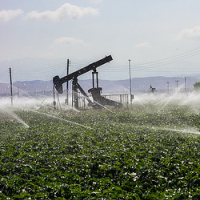Just 5 Weeks from Finding Out What’s in the Oil Wastewater Used on Crops
 (photo: akahawkeyefan/Flickr)
(photo: akahawkeyefan/Flickr)
In these harsh days of drought, who could complain about a vast recycling program that has been around for years, saving billions of gallons of water annually while helping our beleaguered agricultural sector?
The answer is: folks who are concerned about crops being drenched in under-tested oil wastewater. The Los Angeles Times explained why they care.
Chevron provides 10% of Kern County irrigation needs with recycled water from its oil drilling operations. The standards for measuring the toxicity of the water are two-decades old and predate many of the chemicals used in modern extraction techniques, like hydraulic fracturing.
That changed last year with new fracking disclosure laws and regulations. Oil producers have until June 15 to file reports on the chemicals in the treated water they sell for irrigation, including data on fracking chemicals. They can mark chemicals as trade secrets and duke it out with the state if there is disagreement.
The advocacy group Water Defense, founded by actor Mark Ruffalo, didn’t wait for the reports. The Times said the group’s chief scientist, Scott Smith, collected samples for two years from recycled water the Cawelo Water District buys from Chevron and didn’t like what he found: too much oil, acetone, methylene chloride and other toxic chemicals.
Sarah Oktay, a water testing expert at the University of Massachusetts Boston, took a look at the data and said, “I wouldn't necessarily panic, but I would certainly think I would rather not have that.”
Cawelo Water District General Manager David Ansolabehere said Smith screwed up the science and the data was questionable.
Oil drilling produces about 10 barrels of wastewater for every barrel of oil. There is no good way to dispose of it, including injection wells that power it back into the ground (and hopefully not into an aquifer). According to Newsweek, recycled water is pretty much sold at cost to the Cawelo Water District, at a substantial discount compared to market-priced water (assuming it can be had).
The water district sometimes dilutes it with freshwater. That doesn’t necessarily make the aesthetic pleasing. “It’s hot. It’s stinking. There's oil floating on it,” small farmer and environmentalist Tom Frantz told KBAK/KBFX Eyewitness news last month. “Nobody should be eating that food.”
And yet, they do. The Central Valley feeds the nation, as everyone is famously learning during the fourth year of drought and first year of mandatory water restrictions. If someone is eating almonds, artichokes, olives, garlic, broccoli, nectarines, canned tomatoes, celery, apricots, strawberries or cauliflower, there is at least a 90% chance they are eating a Central Valley product.
Frantz said he was worried about the buildup of toxic chemicals and additional briny fracking salt in the soil over time. Rain is usually counted on to wash some of the salt away. That’s not happening now. And “they're sending more water this year than ever before,” Frantz said.
–Ken Broder
To Learn More:
Central Valley's Growing Concern: Crops Raised with Oil Field Water (by Julie Cart, Los Angeles Times)
California Farmers Are Watering Their Crops with Oil Wastewater, and No One Knows What’s in It (by Natasha Geiling, ThinkProgress)
Chevron's Salty, Smelly Water Used on Kern County Crops (by Adam Herbets, KBAK/ KBFX Eyewitness News)
Desperate California Farmers Are Relying on Chevron’s Wastewater (by Lindsay Abrams, Salon)
- Top Stories
- Controversies
- Where is the Money Going?
- California and the Nation
- Appointments and Resignations
- Unusual News
- Latest News
- California Forbids U.S. Immigration Agents from Pretending to be Police
- California Lawmakers Urged to Strip “Self-Dealing” Tax Board of Its Duties
- Big Oil’s Grip on California
- Santa Cruz Police See Homeland Security Betrayal in Use of Gang Roundup as Cover for Immigration Raid
- Oil Companies Face Deadline to Stop Polluting California Groundwater





